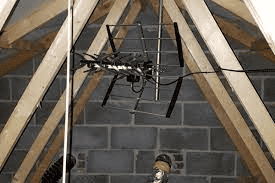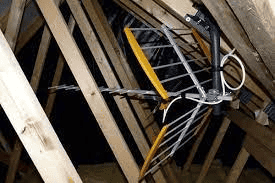Little errors can wreck your TV experience. If you’re intending to install a TV aerial in this space, you should consider these factors:
What is the loft space constructed of?
Wall and roof materials have an impact on how well your loft TV aerial will work. Foil lining can greatly affect the signal. It will bounce the signal off, so it won’t get to the aerial at all.
You should also consider the same thing if your walls and roof have solar panels or metal sheets.
What distance is the nearest TV transmitter?
Antennas in the loft space are better for homes which are at maximum 15 miles from the transmitter. Aerials are designed for different distances from the transmitter, so make sure to use the right one for your home. Find out where the transmitter can be found as you will need to position your TV aerial in an area with optimum signal reception.
Does the path appear clear?
The space between the aerial and the transmitter should not be obstructed. Such obstructions include hilly areas, tall trees or buildings. If the weather is causing trees to sway, this can cause TV reception issues. Despite living near the transmitter, TV reception can be affected by an obstruction in the path.
Is there any interference nearby?
Disturbances may be caused by metallic objects, such as pipes or water tanks in or near your loft. These can detune an aerial. Loft aerials are also prone to interference from impulse noise. You will experience low signal levels, a momentary freezing of the picture, or what’s commonly called your TV image breaking up. For TV aerial installation Gloucester, contact https://steveunettaerials.co.uk/
Where will the TVbe located?
It is important to also consider the distance between your TV and aerial. It is important to know how to determine the amount and type of coaxial lead that you require to connect your HDTV or set-top box to your aerial.
What antenna type do you need?
The success of the loft TV aerial installation is dependent on the type of antenna you use. You will need an antenna which can block out all interference while still picking up weaker signals.
Think about the benefits of high-gain aerials or a log periodic antenna.
Pro-tip: An indoor aerial will probably work in your loft but you might get better results by using an outdoor aerial.


